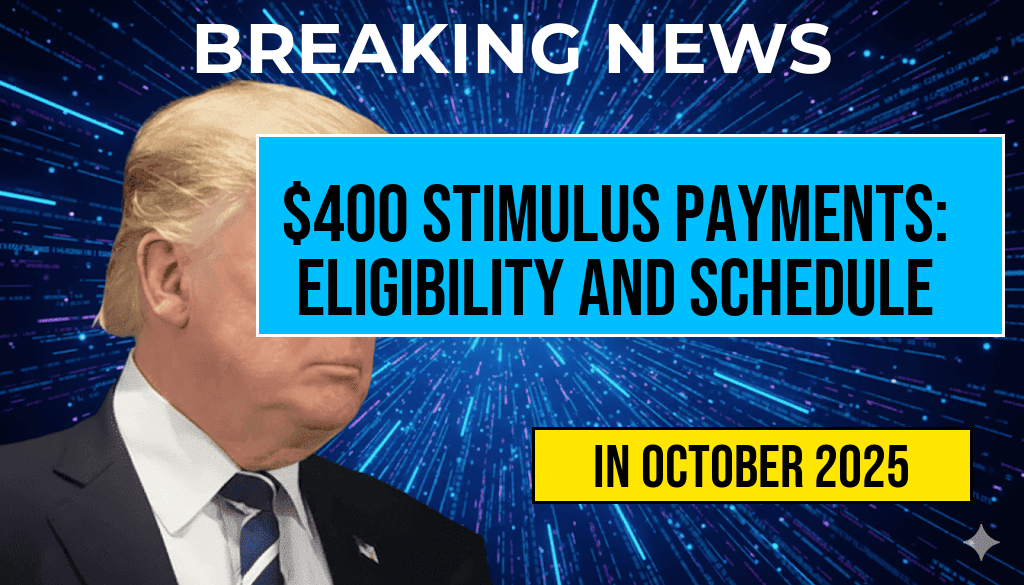The recent announcement of $400 stimulus payments has generated significant attention as many Americans seek financial relief amid ongoing economic challenges. These payments aim to assist eligible individuals and families who are still grappling with the repercussions of the COVID-19 pandemic and rising costs of living. Understanding the eligibility requirements and the comprehensive schedule for these payments is crucial for those hoping to benefit from this financial aid. This article provides an overview of the key details surrounding the $400 stimulus payments, ensuring that recipients are well-informed about the process and timelines involved.
Eligibility Requirements
To qualify for the $400 stimulus payments, applicants must meet certain criteria established by the federal government. The primary eligibility requirements include:
- Income Level: Individuals must have a gross income below a specified threshold, which varies based on family size.
- Residency: Applicants must be U.S. citizens or legal residents residing in the state where the payments are being distributed.
- Age: Payments are typically available to adults aged 18 and older. Dependent children may also qualify for a reduced payment.
Application Process
The application process for the $400 stimulus payments is designed to be straightforward to ensure that eligible individuals can easily access the funds. Here’s how to apply:
- Visit the official government website or designated state portal.
- Provide necessary documentation, such as proof of income and residency.
- Submit the application form electronically or by mail, depending on the state’s guidelines.
It is advisable to apply as soon as the application window opens to avoid delays in processing. States may have different timelines, so staying updated is essential.
Payment Schedule
| State | Payment Start Date | Payment End Date |
|---|---|---|
| California | March 1, 2024 | March 31, 2024 |
| New York | April 1, 2024 | April 15, 2024 |
| Texas | April 15, 2024 | April 30, 2024 |
States are responsible for distributing the payments within their jurisdictions, and recipients should anticipate receiving funds according to the dates outlined in the payment schedule. It is advisable to check with local government resources for any updates or changes to the schedule.
Frequently Asked Questions
How will the payments be distributed?
The $400 stimulus payments will be distributed via direct deposit for those who provided banking information during the application process. Others may receive checks or prepaid debit cards by mail.
What should I do if I do not receive my payment?
If a recipient does not receive their payment within the expected timeframe, they should contact their state’s department of revenue or the agency responsible for stimulus distribution. Keeping records of the application and any correspondence can be helpful.
Will these payments affect my taxes?
The $400 stimulus payments are generally not considered taxable income. However, recipients should consult with a tax professional to understand how these payments may impact their overall tax situation.
Additional Resources
For further information, individuals can visit reliable sources such as:
As the rollout of the $400 stimulus payments progresses, staying informed and aware of the eligibility requirements and payment schedule will be crucial for those seeking this financial assistance. Keeping abreast of updates from official sources can help ensure that individuals do not miss out on this opportunity for support.
Frequently Asked Questions
What are the eligibility requirements for the $400 stimulus payments?
The eligibility requirements for the $400 stimulus payments typically include factors such as income level, residency status, and age. Applicants must generally be a resident of the state offering the payments and meet specific income thresholds set by the government.
When will the $400 stimulus payments be distributed?
The full payment schedule for the $400 stimulus payments varies by state, but many are expected to be distributed in multiple phases throughout the year. It’s important to stay updated through official state announcements for exact dates.
How can I apply for the $400 stimulus payment?
To apply for the $400 stimulus payment, you typically need to fill out an application form provided by your state’s revenue department. Ensure you have all necessary documentation ready to support your eligibility.
Will the $400 stimulus payment affect my taxes?
The $400 stimulus payment is generally considered a form of financial relief and may not be taxable. However, it’s advisable to consult with a tax professional to understand how it may impact your individual tax situation.
What should I do if I don’t receive my $400 stimulus payment?
If you do not receive your $400 stimulus payment by the expected date, contact your state’s revenue office or the agency responsible for distributing the funds. They can assist you in tracking your payment and addressing any issues.

Leave a Reply